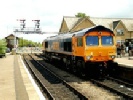Archive Section




A Lecture by Phil Clarke and Cliodhna Loughney
Tuesday 2nd April 2019, 55 Broadway
Written by Peter Lindop
The final talk, illustrated, of the season was given by Phil Clarke (Deputy Director Rolling Stock, London Underground) and Cliodhna Loughney (Senior Engineering Rail Vehicles, Transport for London). Both are engineers, having worked for Leyland Vehicles, Irish Rail, Hitachi, and Alstom amongst others, before joining the CrossRail project. The obvious question was quickly discussed – they are not in a position to answer when the line will open!
The route will be over 60 miles long, from Reading (originally Twyford) and Heathrow in the west, to Shenfield and Abbey Wood in the east. A tunnel under London (the core route) will operate at 24 trains an hour. 26 miles of new tunnel will be needed, all with side walkways. The eight stations in the new tunnel section will have platform edge doors. There are also 5 miles of tunnel already at Heathrow. The lines’ new control centre is at Romford.
A fleet of 70 new trains (originally 65) has been ordered from Bombardier, who have a 32 year maintenance contract. They are based at a new depot at Old Oak Common, west London. Two full cab simulators have also been supplied.
The train is built to a Transport for London (TfL) specification. Built on the Bombardier Aventra platform, it is evolutionary not revolutionary, and is “uniquely identified with CrossRail”. Each car is 23 metres long, with three double doors per side. Units are 9-
The Class 345 unit has three signalling systems; -
We were then shown slides of early development shapes, different yellow front sizes (in the end they don’t have any front yellow, the first mainline fleet without), livery, interior and exterior designs. Sighting of stop boards from the cab side windows was another issue. Mock-
Next we saw views of test trains; -
CCTV is fitted, with two screens in each cab, each screen showing four views. A full view along a platform is vital for DOO, with a live image in the cab as a train departs. Views are both from the train and from platform mounted cameras (via leaky feeder cables). Forward facing CCTV if fitted, it can be used if a train needs to reverse in the tunnel section in emergency for example. Cameras are also fitted throughout the carriages. Inside every car are ceiling mounted display units. Part of the “Passenger Information System”, they can display the time, route maps, line status updates, or live messages from the control room.
The driver responds to the TCMS (On-
Train simulators were originally installed at Ilford depot, they are now at Old Oak Common depot. The new depot opened in June 2018, and covers 14 Hectares. Before then the trains were maintained at Ilford. There are 9 main roads inside the depot, with 33 sidings outside. A double headed Hegenscheidt wheel lathe is on site, along with a train wash, and the monitoring station. There are also six stabling locations along the routes. We then saw photographs of the depot under construction, and the adjacent HS2 site. A 2 minute film showed the trains being constructed at Derby.
A Question and Answer session covered a variety of subjects;-
- The height of carriage ceiling displays from the floor, and grab pole heights started the session. They do meet standards;
- White out when leaving tunnels – this can be a serious problem (especially at Paddington in the afternoon sun), tinted glass, angled windows all can help;
- Auto reverse – failures in single line tunnels can cause big problems, in an emergency trains can be automatically reversed out;
- Liverpool Street service – can they recover time if delayed? Yes, units have the traction power to do it. The 0-
60 mph time is the quickest in the UK. The traction is over spec for the current/proposed requirements;
- GWR ATP – It’s still in use as Heathrow Express need it;
- Class 345 to Heathrow – some have run under test conditions;
- Couplings – Dellner couplings are fitted at the ends.
- With that we thanked Cliodhna and Phil in the usual way for a very interesting talk.